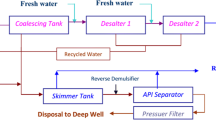Abstract
This study aims to find an appropriate way to minimize water utility in the petrochemical and petroleum industries due to high rate of water consumption. For this purpose, Tehran oil refinery has been well studied. In this research, three key contaminants including suspended solid, hardness as well as COD have been considered to analyze the water network. In addition, the potential of water reuse was studied for all methods. These key contaminants once were analyzed separately as a single contaminant and the amount of required freshwater was calculated for them. In this stage, amount of freshwater was reduced to about 60.9 (17%), 203 (59.7%) and 143 m3/h (42.5%) in terms of suspended solids, hardness, and COD, respectively. Water minimization within operations for suspended solids is less than two others. Therefore, this is a limiting contaminant and can be selected as a key contaminant. In the next stage, three contaminants were analyzed two by two based on their mass transfer. Results show that, in the targeting for minimization based on the suspended solids and hardness, the amount of required water is reduced to 142.74 m3/h or 42%. This amount for suspended solids and COD is equal to 86.3 m3/h (26%) and for COD and hardness is 124 m3/h (37%). Analyzing the methods shows that the method based on the double contaminant gives more precise results rather than single contaminant.
Similar content being viewed by others
References
Alva-Argaez, A., Kokossis, A. C., & Smith R. (2007). The design of water-using systems in petroleum refining using a water-pinch decomposition. Chemical Engineering Journal, 128(1), 33–46.
Ataei, A., Panjeshahi M. H., & Gharaie, M. (2009b). New method for industrial water reuse and energy minimization. International Journal of Environmental Research, 3, 289–300.
Ataei, A., Panjeshahi, M. H., & Karbassian, S. (2009a). Simultaneous energy and water minimization approach for systems with optimum regeneration of wastewater. Research Journal of Environmental Sciences, 3(6), 604–618.
Ataei, A., & Yoo, C. (2010). Combined pinch and energy analysis for exergy efficiency optimization in a steam power plant. International Journal of the Physical Sciences, 5(7), 1110–1123.
Bagajewicz, M. (2000). A review of recent design procedures for water networks in refineries and process plants. Computers & chemical engineering, 24(9–10), 2093–2113.
Dhole, V. R., Ramchandi, N., Tanish, R. A., & Wasileswski, M. (1996). Make your process water pay for itself. Chemical Engineering Journal, 103(1), 100–103.
El Halwagi, M. (2006). Preface. Process System Engineering, 7, vii–x.
Foo, D. C., Manan, Z. A., & Tan, Y. L. (2005). Synthesis of maximum water recovery network for batch process systems. Journal of Cleaner Production, 13(15), 1381–1394.
Gomes, J., Queiroz, F., & Pessoa, L. P. (2006). Design procedure for water/wastewater minimization: Single contaminant. Journal of Cleaner Production, 15(5), 474–485.
Gomes, J, Savelski, M., & Bagajewicz, M. (2001). On a systematic design procedure single component water utilization systems in process plants. Chemical Engineering Communications, 186, 183–203.
Kuo, K., & Smith, R. (1997). Effluent treatment system design. Chemical Engineering Science, 23, 4273–4290.
Kuo, K., & Smith, R. (1998). Design of water using systems involving regeneration. Process Safety and Environmental Protection, 76(2), 94–114.
Manan, Z. A., Wan Alwi, S. R., & Ujang, Z. (2006). Water pinch analysis for an urban system: A case study on the Sultan Ismail Mosque at the University Technology Malaysia (UTM). Desalination, 194(1–3), 52–68.
Mann, G., & Liu, Y. A. (1999). Industrial water reuse and wastewater minimization. McGraw hill.
Mehrdadi, N., Nabi Bidhendi, G. R., & Mohammadnejad, S. (2009). An overview on different water pinch methods for industrial water and wastewater minimization. Environmental Sciences, 6(4), 29–42 (published by Shahid Beheshti University (ISSN, 1735-1324)).
Mohammadnejad, S. (2009). Industrial solid wastes and their management in Gilan Province. Asian Journal of Chemistry, 21(2), 1581–1588.
Mohammadnejad, S., Nabi Bidhendi, G. R., & Mehrdadi, N. (2010). A new algorithm for water and wastewater optimization in multiple contaminant network using water pinch technology. Research Journal of Environmental Science, 4(3), 193–208.
Mohammadnejad, S., Nabi Bidhendi, G. R., & Mehrdadi, N. (2011a). Water and wastewater minimization in petroleum refinery through water pinch analysis—Single and double contaminants approach. Research Journal of Environmental Science, 5(1), 83–98.
Mohammadnejad, S., Nabi Bidhendi, G. R., & Mehrdadi, N. (2011b). Water pinch analysis in oil refinery using regeneration reuse and recycling consideration. Desalination, 265(1–3), 255–265.
Nabi Bidhendi, G. R., Mehrdadi, N., & Mohammadnejad, S. (2010). Water and wastewater minimization in Tehran oil refinery using water pinch analysis. International Journal of Environmental Research, 4(4), 583–594.
Panjeshahi, M. H., Gharaie, M., & Ataei, A. (2010). Debottlenecking procedure of effluent thermal treatment system. Energy, 35(12), 5202–5208
Ulson, A. A., Forgiarini, E., Brandao, H. L., Xavier, M. F., Pessoa, F. L. P., Guelli, U., et al. (2009). Application of Water Source Diagram (WSD) method for the reduction of water consumption in petroleum refineries. Resources, Conservation & Recycling, 53(3), 149–154.
Wang, Y. P., & Smith, R. (1994). Wastewater minimization. Chemical Engineering Science, 49, 981–1006.
Author information
Authors and Affiliations
Corresponding author
Rights and permissions
About this article
Cite this article
Mohammadnejad, S., Ataei, A., Bidhendi, G.R.N. et al. Water pinch analysis for water and wastewater minimization in Tehran oil refinery considering three contaminants. Environ Monit Assess 184, 2709–2728 (2012). https://doi.org/10.1007/s10661-011-2146-z
Received:
Accepted:
Published:
Issue Date:
DOI: https://doi.org/10.1007/s10661-011-2146-z




